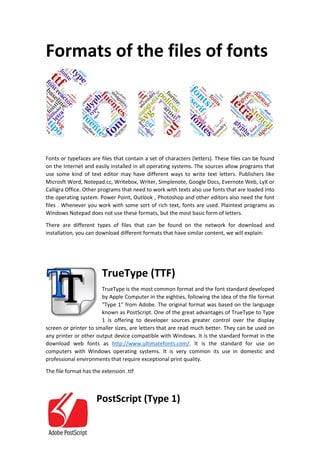
Font file formats: TrueType (TTF), PostScript y OpenType (OTF)
- 1. Formats of the files of fonts Fonts or typefaces are files that contain a set of characters (letters). These files can be found on the Internet and easily installed in all operating systems. The sources allow programs that use some kind of text editor may have different ways to write text letters. Publishers like Microsft Word, Notepad.cc, Writebox, Writer, Simplenote, Google Docs, Evernote Web, LyX or Calligra Office. Other programs that need to work with texts also use fonts that are loaded into the operating system. Power Point, Outlook , Photoshop and other editors also need the font files . Whenever you work with some sort of rich text, fonts are used. Plaintext programs as Windows Notepad does not use these formats, but the most basic form of letters. There are different types of files that can be found on the network for download and installation, you can download different formats that have similar content, we will explain: TrueType (TTF) TrueType is the most common format and the font standard developed by Apple Computer in the eighties, following the idea of the file format "Type 1" from Adobe. The original format was based on the language known as PostScript. One of the great advantages of TrueType to Type 1 is offering to developer sources greater control over the display screen or printer to smaller sizes, are letters that are read much better. They can be used on any printer or other output device compatible with Windows. It is the standard format in the download web fonts as http://www.ultimatefonts.com/. It is the standard for use on computers with Windows operating systems. It is very common its use in domestic and professional environments that require exceptional print quality. The file format has the extension .ttf PostScript (Type 1)
- 2. PostScript is the first file format for fonts. Created by Adobe primarily for printers. It is a "page description language" (PDL Page Description Language), used in many older printers. It started to developing in 1976 and then moved to Xerox with PARC. Its developer was John Warnock which used that developing to found Adobe in 1982 . This is the original format of these files and today is still used. PostScript differed from other basic formats of printers that used a full programming language to describe a print image. A file can be sent to a laser printer or other high quality output device. For the font files has 300 DPI, dots per inch. This format is not usually found on download sites, it’s a more professional format, but still used. PostScript fonts are smoother, detailed, high-quality letters, but are heavier files. It’s use is more restricted to formats for printing, especially for professional-quality printing books, posters and magazines. Windows operating systems support this format without problems, but their weight makes them inadvisable to use. The file format has the extension .ps This example is taken from Wikipedia of how the code is presented in this language. http://en.wikipedia.org/wiki/PostScript OpenType (OTF)
- 3. OpenType was created by Microsoft and Adobe to be the next step in Apple TrueType and PostScript format Adobe. Microsoft wanted to have their own format and tried with the typefaces advanced technology, "GX Typography", but that did not work and developed TrueType Open in 1994. Joined Adobe technology contributing to the development of the Type 1 format. Binding of both resulted to OpenType. Adobe and Microsoft continued development and support for the OpenType format to become a universal open standard format for all computers. The Office of International Standards (International Organization for Standardization, ISO) adopted it as a standard format, but has not finished universalized, it’s the second format most used by current operating systems. The file format has the extension .otf Formats of fonts for operating systems All formats are compatible, current programs and Microsoft Windows operating systems support all three formats. Computers with Mac operating systems such as Mac OS X also supports three formats. This operating system is installed by default Font Book program to manage these files. The Linux-based operating systems also support formats fonts, although the file management system is different.
